Abstract
To examine the role of enteric adenoviruses (EAV) in an urban area of Buenos Aires (Argentina), we prospectively studied faecal samples from 49 families of newborns. These were monitored weekly for diarrhoea for 2 years. A total of 180 samples from cases of diarrhoea and 766 samples obtained during diarrhoea-free periods were studied by dot-blot hybridization with an EAV-specific DNA probe. EAV were found in 6/180 (3.3%) cases of diarrhoea and 6/766 (0.8%) asymptomatic samples (P < 0.015). Incidence of EAV was 3.9 cases per 100 person-years in children < 60 months old. EAV-related diarrhoeas were slight and of short duration. In addition, 129 faeces from hospital out-patients, 1-30 months old, were also studied. EAV was identified in 7/129 cases (5.4%). These cases were 9.5 +/- 3.5 months old and the diarrhoea was mild or severe, of 3 +/- 1.5 days of duration. We suggest that EAV are low-risk causes of diarrhoea under natural conditions, although a few children may develop more severe diarrhoea. The diagnosis of EAV needs to be considered in these patients.
Full text
PDF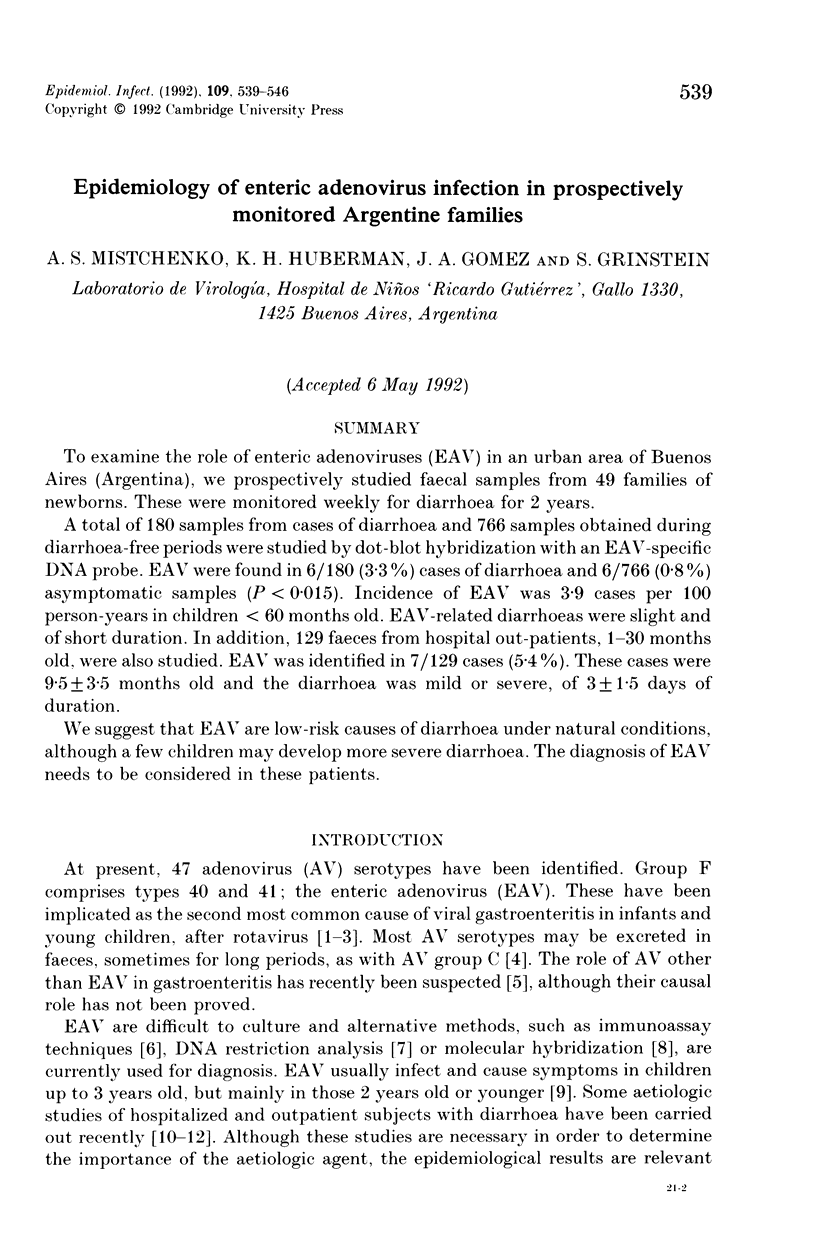
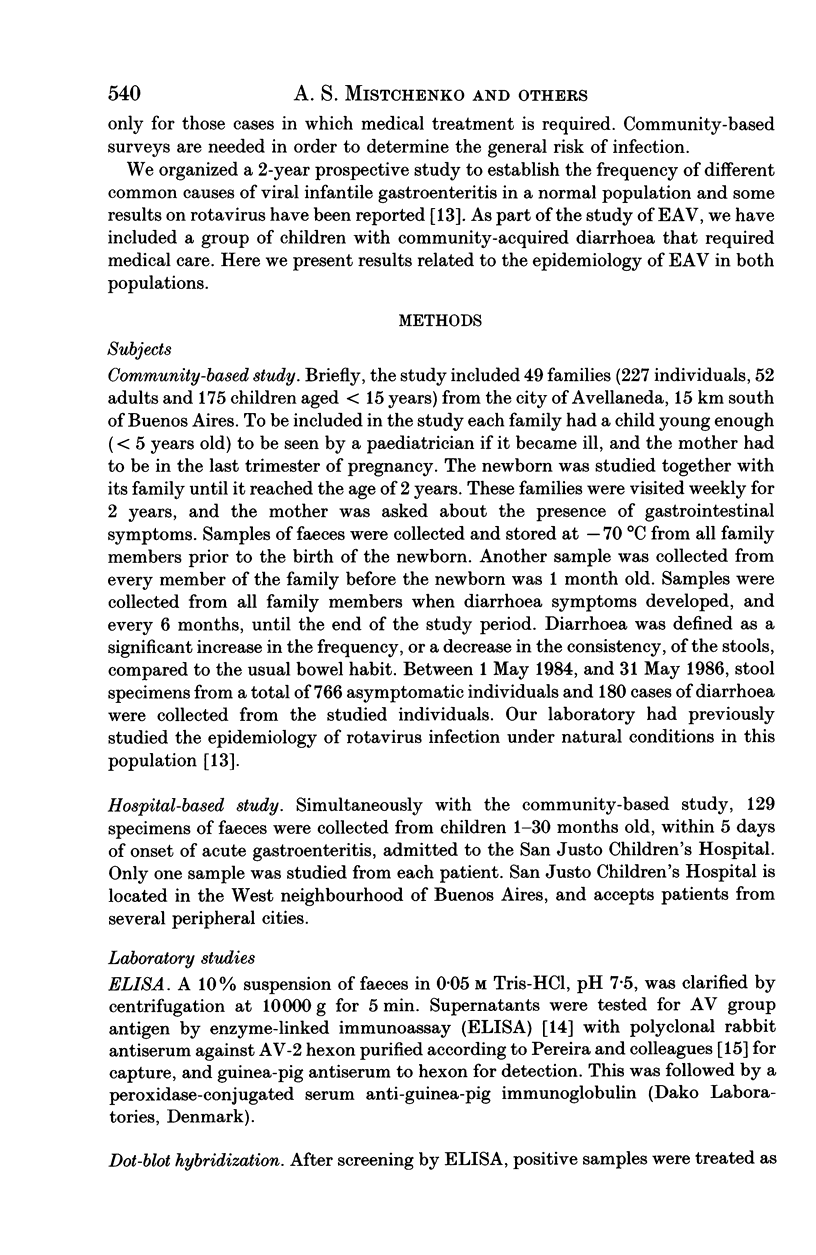
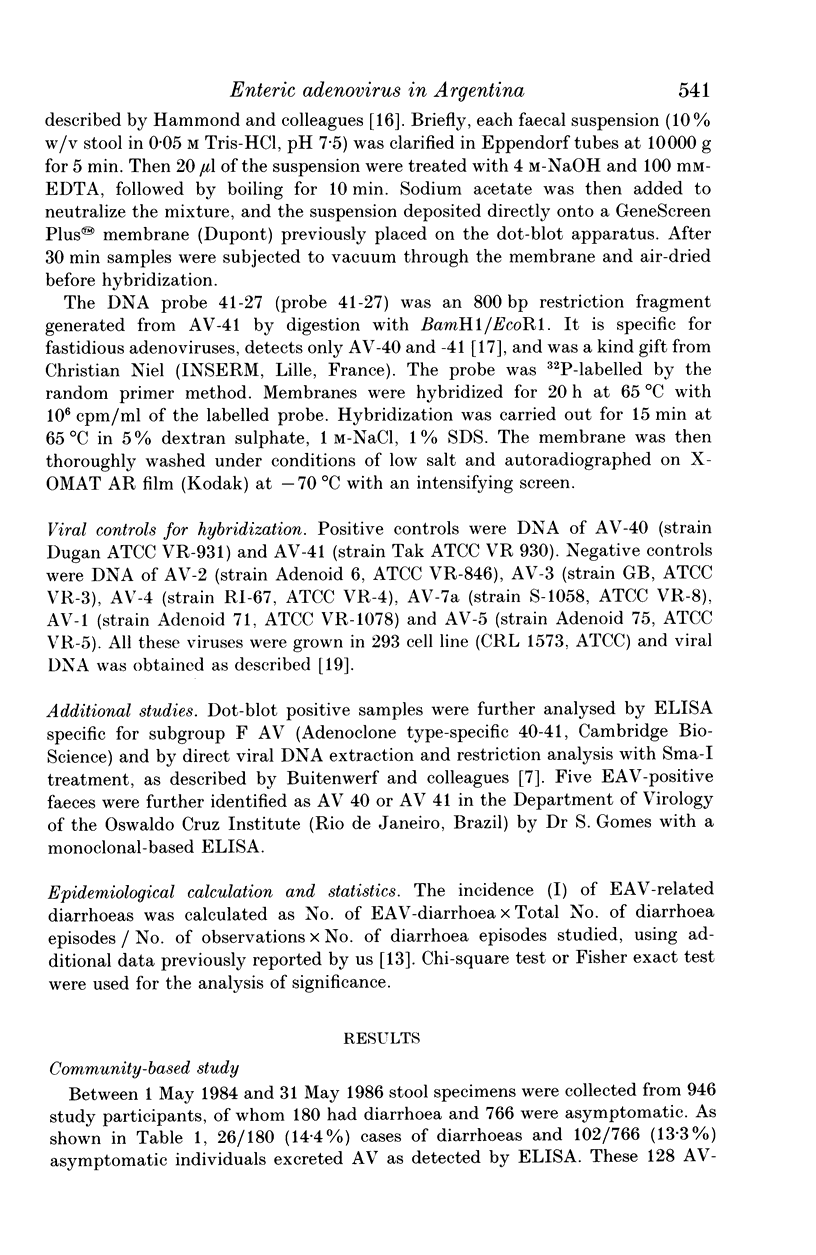
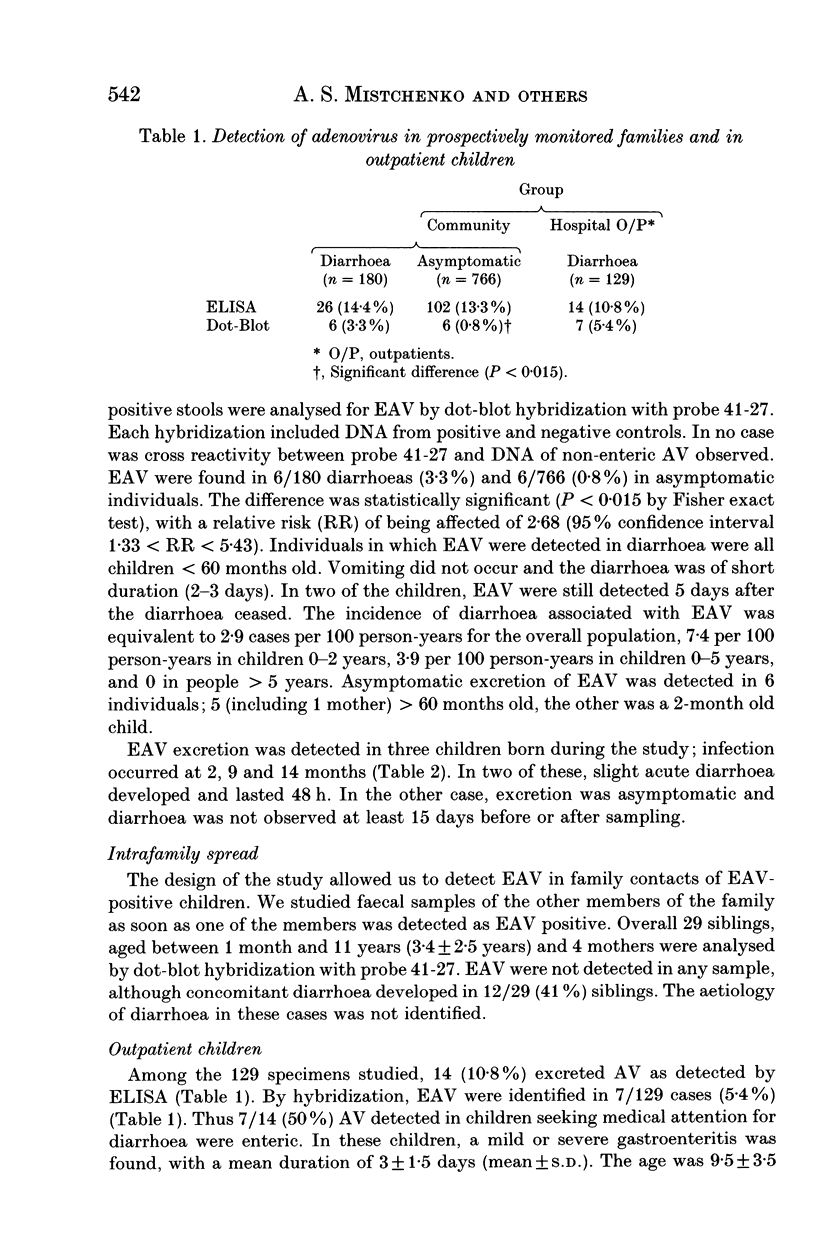

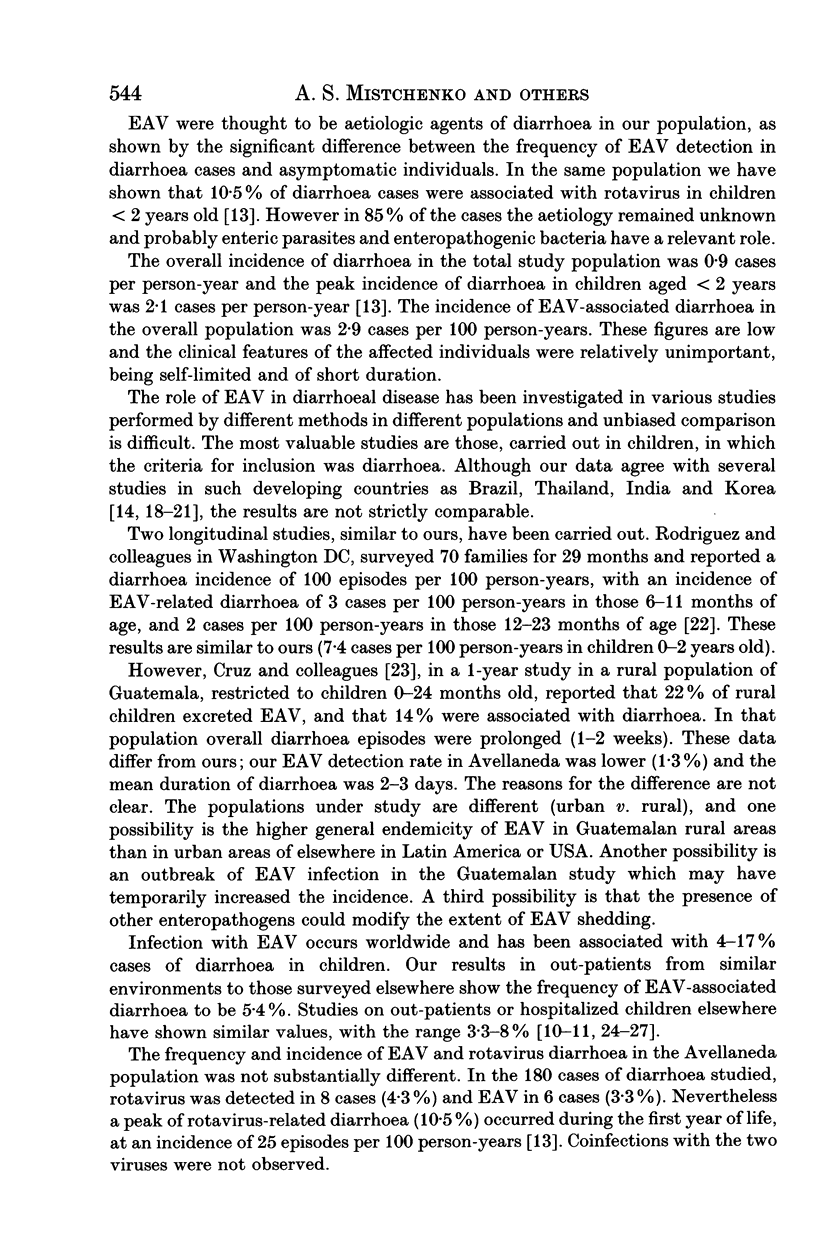
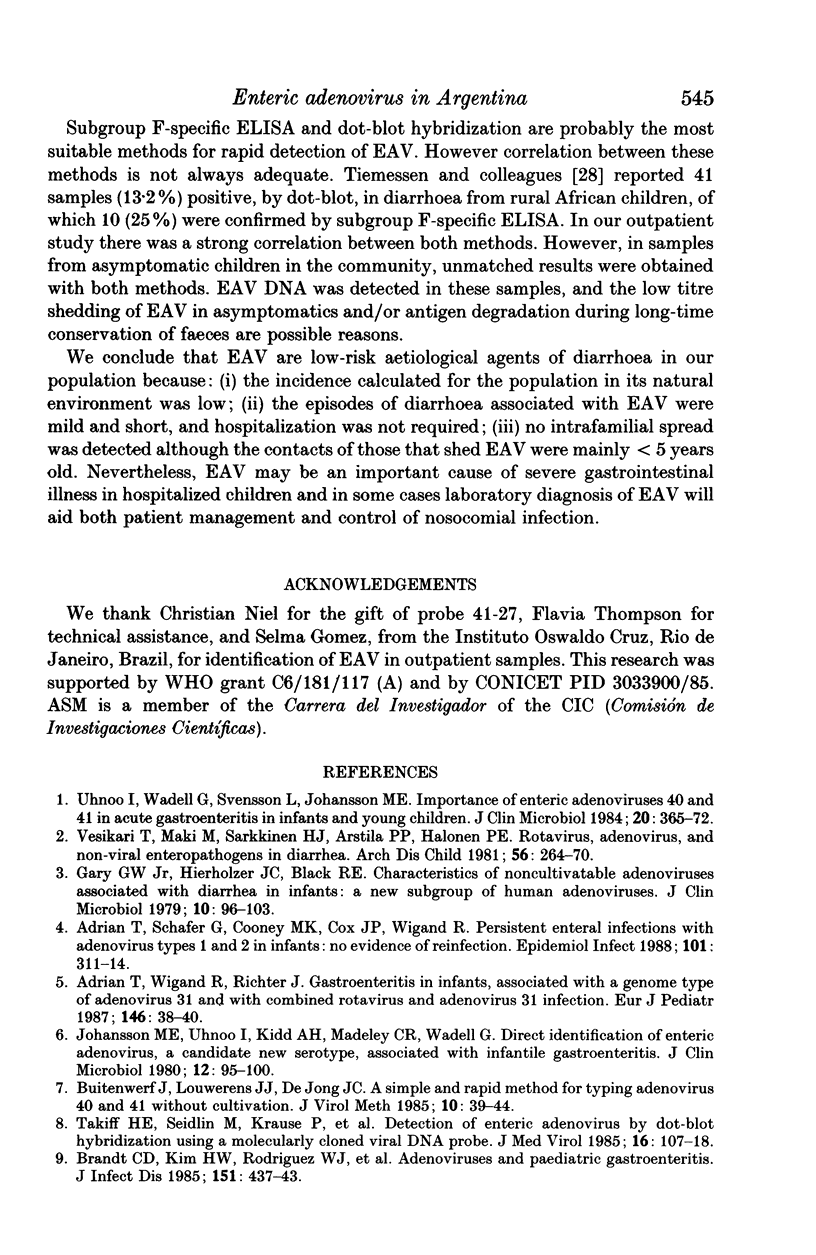
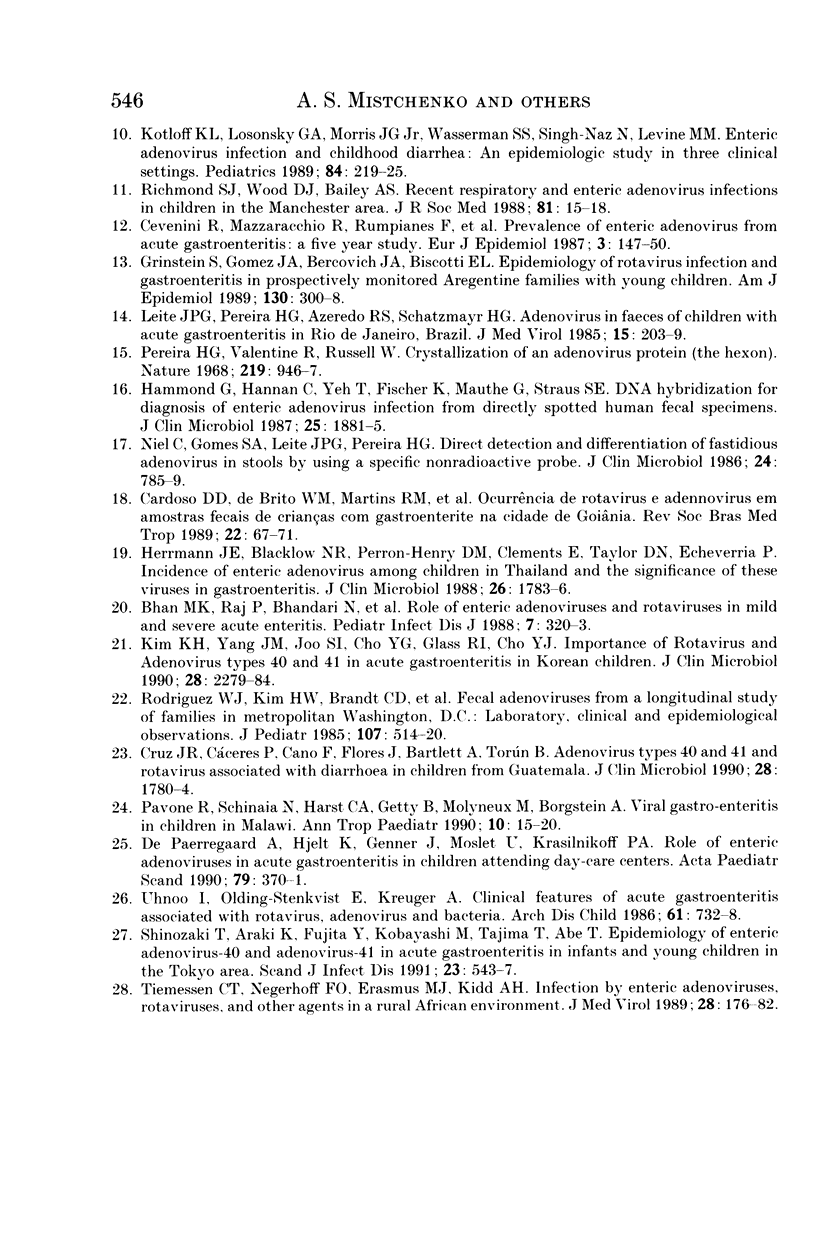
Selected References
These references are in PubMed. This may not be the complete list of references from this article.
- Adrian T., Wigand R., Richter J. Gastroenteritis in infants, associated with a genome type of adenovirus 31 and with combined rotavirus and adenovirus 31 infection. Eur J Pediatr. 1987 Jan;146(1):38–40. doi: 10.1007/BF00647280. [DOI] [PubMed] [Google Scholar]
- Bhan M. K., Raj P., Bhandari N., Svensson L., Stintzing G., Prasad A. K., Jayashree S., Srivastava R. Role of enteric adenoviruses and rotaviruses in mild and severe acute enteritis. Pediatr Infect Dis J. 1988 May;7(5):320–323. doi: 10.1097/00006454-198805000-00005. [DOI] [PubMed] [Google Scholar]
- Brandt C. D., Kim H. W., Rodriguez W. J., Arrobio J. O., Jeffries B. C., Stallings E. P., Lewis C., Miles A. J., Gardner M. K., Parrott R. H. Adenoviruses and pediatric gastroenteritis. J Infect Dis. 1985 Mar;151(3):437–443. doi: 10.1093/infdis/151.3.437. [DOI] [PubMed] [Google Scholar]
- Buitenwerf J., Louwerens J. J., De Jong J. C. A simple and rapid method for typing adenoviruses 40 and 41 without cultivation. J Virol Methods. 1985 Jan;10(1):39–44. doi: 10.1016/0166-0934(85)90086-2. [DOI] [PubMed] [Google Scholar]
- Cardoso D. D., de Brito W. M., Martins R. M., Kitajima E. W., Souza M. P., Barbosa A. J., de Oliveira S. A., Rascopi S. B. Ocorrência de rotavírus e adenovírus em amostras fecais de crianças com gastrenterite, na cidade de Goiânia. Rev Soc Bras Med Trop. 1989 Apr-Jun;22(2):67–71. doi: 10.1590/s0037-86821989000200001. [DOI] [PubMed] [Google Scholar]
- Cevenini R., Mazzaracchio R., Rumpianesi F., Donati M., Moroni A., Sambri V., La Placa M. Prevalence of enteric adenovirus from acute gastroenteritis: a five year study. Eur J Epidemiol. 1987 Jun;3(2):147–150. doi: 10.1007/BF00239751. [DOI] [PubMed] [Google Scholar]
- Cruz J. R., Cáceres P., Cano F., Flores J., Bartlett A., Torún B. Adenovirus types 40 and 41 and rotaviruses associated with diarrhea in children from Guatemala. J Clin Microbiol. 1990 Aug;28(8):1780–1784. doi: 10.1128/jcm.28.8.1780-1784.1990. [DOI] [PMC free article] [PubMed] [Google Scholar]
- Gary G. W., Jr, Hierholzer J. C., Black R. E. Characteristics of noncultivable adenoviruses associated with diarrhea in infants: a new subgroup of human adenoviruses. J Clin Microbiol. 1979 Jul;10(1):96–103. doi: 10.1128/jcm.10.1.96-103.1979. [DOI] [PMC free article] [PubMed] [Google Scholar]
- Grinstein S., Gómez J. A., Bercovich J. A., Biscotti E. L. Epidemiology of rotavirus infection and gastroenteritis in prospectively monitored Argentine families with young children. Am J Epidemiol. 1989 Aug;130(2):300–308. doi: 10.1093/oxfordjournals.aje.a115336. [DOI] [PubMed] [Google Scholar]
- Hammond G., Hannan C., Yeh T., Fischer K., Mauthe G., Straus S. E. DNA hybridization for diagnosis of enteric adenovirus infection from directly spotted human fecal specimens. J Clin Microbiol. 1987 Oct;25(10):1881–1885. doi: 10.1128/jcm.25.10.1881-1885.1987. [DOI] [PMC free article] [PubMed] [Google Scholar]
- Herrmann J. E., Blacklow N. R., Perron-Henry D. M., Clements E., Taylor D. N., Echeverria P. Incidence of enteric adenoviruses among children in Thailand and the significance of these viruses in gastroenteritis. J Clin Microbiol. 1988 Sep;26(9):1783–1786. doi: 10.1128/jcm.26.9.1783-1786.1988. [DOI] [PMC free article] [PubMed] [Google Scholar]
- Johansson M. E., Uhnoo I., Kidd A. H., Madeley C. R., Wadell G. Direct identification of enteric adenovirus, a candidate new serotype, associated with infantile gastroenteritis. J Clin Microbiol. 1980 Jul;12(1):95–100. doi: 10.1128/jcm.12.1.95-100.1980. [DOI] [PMC free article] [PubMed] [Google Scholar]
- Kim K. H., Yang J. M., Joo S. I., Cho Y. G., Glass R. I., Cho Y. J. Importance of rotavirus and adenovirus types 40 and 41 in acute gastroenteritis in Korean children. J Clin Microbiol. 1990 Oct;28(10):2279–2284. doi: 10.1128/jcm.28.10.2279-2284.1990. [DOI] [PMC free article] [PubMed] [Google Scholar]
- Kotloff K. L., Losonsky G. A., Morris J. G., Jr, Wasserman S. S., Singh-Naz N., Levine M. M. Enteric adenovirus infection and childhood diarrhea: an epidemiologic study in three clinical settings. Pediatrics. 1989 Aug;84(2):219–225. [PubMed] [Google Scholar]
- Leite J. P., Pereira H. G., Azeredo R. S., Schatzmayr H. G. Adenoviruses in faeces of children with acute gastroenteritis in Rio de Janeiro, Brazil. J Med Virol. 1985 Feb;15(2):203–209. doi: 10.1002/jmv.1890150213. [DOI] [PubMed] [Google Scholar]
- Niel C., Gomes S. A., Leite J. P., Pereira H. G. Direct detection and differentiation of fastidious and nonfastidious adenoviruses in stools by using a specific nonradioactive probe. J Clin Microbiol. 1986 Nov;24(5):785–789. doi: 10.1128/jcm.24.5.785-789.1986. [DOI] [PMC free article] [PubMed] [Google Scholar]
- Paerregaard A., Hjelt K., Genner J., Moslet U., Krasilnikoff P. A. Role of enteric adenoviruses in acute gastroenteritis in children attending day-care centres. Acta Paediatr Scand. 1990 Mar;79(3):370–371. doi: 10.1111/j.1651-2227.1990.tb11475.x. [DOI] [PubMed] [Google Scholar]
- Pavone R., Schinaia N., Hart C. A., Getty B., Molyneux M., Borgstein A. Viral gastro-enteritis in children in Malawi. Ann Trop Paediatr. 1990 Mar;10(1):15–20. doi: 10.1080/02724936.1990.11747402. [DOI] [PubMed] [Google Scholar]
- Pereira H. G., Valentine R. C., Russell W. C. Crystallization of an adenovirus protein (the hexon). Nature. 1968 Aug 31;219(5157):946–947. doi: 10.1038/219946a0. [DOI] [PubMed] [Google Scholar]
- Richmond S. J., Wood D. J., Bailey A. S. Recent respiratory and enteric adenovirus infection in children in the Manchester area. J R Soc Med. 1988 Jan;81(1):15–18. doi: 10.1177/014107688808100108. [DOI] [PMC free article] [PubMed] [Google Scholar]
- Rodriguez W. J., Kim H. W., Brandt C. D., Schwartz R. H., Gardner M. K., Jeffries B., Parrott R. H., Kaslow R. A., Smith J. I., Takiff H. Fecal adenoviruses from a longitudinal study of families in metropolitan Washington, D.C.: laboratory, clinical, and epidemiologic observations. J Pediatr. 1985 Oct;107(4):514–520. doi: 10.1016/s0022-3476(85)80007-x. [DOI] [PubMed] [Google Scholar]
- Shinozaki T., Araki K., Fujita Y., Kobayashi M., Tajima T., Abe T. Epidemiology of enteric adenoviruses 40 and 41 in acute gastroenteritis in infants and young children in the Tokyo area. Scand J Infect Dis. 1991;23(5):543–547. doi: 10.3109/00365549109105175. [DOI] [PubMed] [Google Scholar]
- Takiff H. E., Seidlin M., Krause P., Rooney J., Brandt C., Rodriguez W., Yolken R., Straus S. E. Detection of enteric adenoviruses by dot-blot hybridization using a molecularly cloned viral DNA probe. J Med Virol. 1985 Jun;16(2):107–118. doi: 10.1002/jmv.1890160203. [DOI] [PubMed] [Google Scholar]
- Tamura K., Sakazaki R., Kuramochi S., Nakamura A. Occurrence of H-antigen Z66 of R phase in cultures of Salmonella serovar typhi originated from Indonesia. Epidemiol Infect. 1988 Oct;101(2):311–314. doi: 10.1017/s0950268800054236. [DOI] [PMC free article] [PubMed] [Google Scholar]
- Tiemessen C. T., Wegerhoff F. O., Erasmus M. J., Kidd A. H. Infection by enteric adenoviruses, rotaviruses, and other agents in a rural African environment. J Med Virol. 1989 Jul;28(3):176–182. doi: 10.1002/jmv.1890280313. [DOI] [PMC free article] [PubMed] [Google Scholar]
- Uhnoo I., Olding-Stenkvist E., Kreuger A. Clinical features of acute gastroenteritis associated with rotavirus, enteric adenoviruses, and bacteria. Arch Dis Child. 1986 Aug;61(8):732–738. doi: 10.1136/adc.61.8.732. [DOI] [PMC free article] [PubMed] [Google Scholar]
- Uhnoo I., Wadell G., Svensson L., Johansson M. E. Importance of enteric adenoviruses 40 and 41 in acute gastroenteritis in infants and young children. J Clin Microbiol. 1984 Sep;20(3):365–372. doi: 10.1128/jcm.20.3.365-372.1984. [DOI] [PMC free article] [PubMed] [Google Scholar]
- Vesikari T., Mäki M., Sarkkinen H. K., Arstila P. P., Halonen P. E. Rotavirus, adenovirus, and non-viral enteropathogens in diarrhoea. Arch Dis Child. 1981 Apr;56(4):264–270. doi: 10.1136/adc.56.4.264. [DOI] [PMC free article] [PubMed] [Google Scholar]


